2010 Pichilemu earthquake
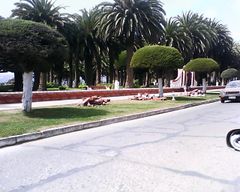 |
|
| Balustrades of Agustín Ross Park were destroyed after 2010 Pichilemu earthquake. | |
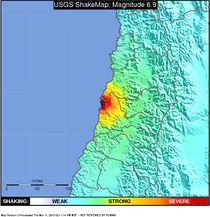 |
|
| Date | 11:39:48, 11 March 2010 (UTC-3) |
|---|---|
| Magnitude | 6.9 Mw[1][2] |
| Depth | 31.2 kilometres (19 mi)[2] |
| Epicenter location | Pichilemu, Chile |
| Countries or regions affected | |
| Max. intensity | MM X |
| Tsunami | Small tsunami |
| Casualties | 1 dead |
The 2010 Pichilemu earthquake (Spanish: Terremoto en Pichilemu de 2010) was a 6.9 magnitude earthquake that occurred on 11 March 2010, at 11:39 local time (14:39 UTC). It was positioned southwest of Pichilemu, O'Higgins Region, Chile. The Hawaii-based Pacific Tsunami Warning Center pointed out the possibility of local tsunamis within 100 kilometres (62 mi) of the epicenter.[3] One person was reported dead.
The earthquake was caused by increased regional stress arising from an earthquake on 27 February, centered offshore Maule Region, which was felt throughout central Chile.[1] The 11 March earthquake was at first thought to be aftershocks from the 27 February event, but University of Chile Seismologist Jaime Campos identified it as an "independent earthquake". At least 11 aftershocks followed, causing panic throughout coastal towns between the Coquimbo and Los Lagos regions.[4][5]
Pichilemu is a Chilean city, capital of Cardenal Caro Province, O'Higgins Region.[6] As of 2002, it had 12,392 inhabitants.[7] The city hosts five National Monuments of Chile, such as the Agustín Ross Park, Cultural Centre and Agustín Ross Hotel.[8] Tourism is the main industry of the city.[9] Several surf championships take place every year in Punta de Lobos, which according to Fodor's is "widely considered the best surfing in South America year-round."[10]
Contents |
Background and geology
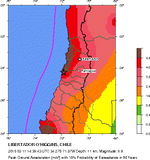
Although news media reported the earthquake as an aftershock of the February earthquake in Chile,[11][12] a preliminary geological summary issued by the United States Geological Survey considered it to be an independent earthquake,[1] a conclusion which seismologist Jaime Campos of the University of Chile also reached.[13]
The earthquake occurred in the region of the plate boundary between the Nazca and South America plates, in the aftershock region of the 27 February earthquake, that occurred offshore Maule Region.[14] The Pichilemu earthquake was caused by the change in regional stress from the 27 February earthquake. Preliminary analyses of their locations and seismic-wave radiation patterns suggest that the Pichilemu earthquake resulted from normal faulting within the subducting Nazca plate or the overriding South America plate, unlike the 27 February earthquake, which occurred as thrust faulting on the interface between the two plates. The focal depths of the Pichilemu earthquake are not known with sufficient precision to determine whether the Nazca or South American plate caused the earthquake.[1] From the pattern of aftershocks, it has been suggested that this earthquake originated from rupture along a previously unknown fault between Pichilemu and Vichuquén at 15 km depth, 40 km in length and 20 km wide.[15] It is not known whether this fault was formed during the earthquake or if it was just reactivated.[16]
The earthquake occurred 40 kilometres (25 mi) southwest of Pichilemu, at a depth of 31.2 kilometres (19.4 mi) according to the University of Chile Seismological Service.[2][17][18][19] and as of 15 March 2010, more than 50 aftershocks had occurred in the area.[20]
Reaction
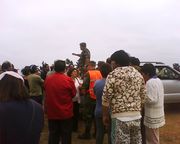
The earthquake took place shortly before the new President of Chile, Sebastián Piñera, was sworn in, at about 12:15 local time (15:15 UTC), at the Chilean congress in Valparaíso, where the shaking was clearly felt.[21] The presidents of Argentina, Bolivia, Colombia, Ecuador and Paraguay were also present, but television footage showed that the inauguration was not interrupted.[22]
A Pacific-wide tsunami warning was not issued by the Pacific Tsunami Warning Center, although they pointed out the possibility of local tsunamis within 100 kilometres (62 mi) of the epicenter, between La Serena and Concepción.[3] The Hydrographic and Oceanographic Service—SHOA, a Chilean Navy agency, issued a tsunami warning between Coquimbo and Los Lagos regions.[23][24] The tsunami warning was lifted at around 15:50 local time (18:50 UTC).[25] People in Pichilemu went to La Cruz Hill for their safety.[26]
President Piñera "urged coastal residents to move to higher ground in case of a tsunami,"[24] decreed "catastrophe state" in O'Higgins Region, and appointed Army General Antonio Yackcich as Jefe de Plaza (English: Place Head) for the region, while he was visiting Rancagua that day.[27][28]
Damage and casualties
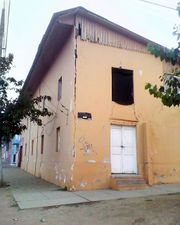
At Pichilemu, its epicenter, the earthquake destroyed Agustín Ross Park, most of Agustín Ross Cultural Centre, and severely damaged the Espinillo and Rodeíllo villages.[29][30] One death was reported in Talca.[31] The earthquake was also reported to have been felt in Mendoza,[32] Bariloche, Córdoba, San Rafael, Buenos Aires, Montevideo and Asunción.[33][34]
According to a report by the National Emergencies Office of Chile on 11 March 2010, small waves were seen in the area surrounding Pichilemu. The Santa Julia overpass located between Rancagua and Graneros collapsed, and there were partial power outages in Mostazal, San Fernando and Peumo.[35]
A United States Geological Survey summary of the earthquake reported damage at Rancagua,[1] 177 kilometers southwest of Pichilemu.[36] The mayor of Rancagua, Eduardo Soto, reported severe damage to homes in the town.[37] A small tsunami was also reported, with sea wave heights of 16 centimetres (0.525 ft) at Valparaíso, and 29 centimetres (0.951 ft) at San Antonio.[1] Interior Minister Rodrigo Hinzpeter reported strong waves in Pichilemu[38] and Bucalemu, and damage to a highway in O'Higgins Region.[39]
Relief efforts stalled for about six hours because of the constant aftershocks.[39] Seismologist Mario Pardo from the University of Chile Seismological Service told Radio Cooperativa on 15 March 2010 that it was thought Pichilemu was experiencing a seismic swarm, due to concerns about the continued aftershocks in the area.[40] After several power outages and tsunami alerts, many people in Pichilemu stayed at La Cruz Hill and at Cordón, Cáhuil.[30][41]
Aftershocks
Within the following six hours there were ten aftershocks, two of magnitude 6 or greater, and seven between 5 and 6.[4]
| Date | Local time | Location | Coordinates | Depth | MW | Notes |
|---|---|---|---|---|---|---|
| 11 March 2010 | 11:39:48 | Pichilemu, O'Higgins | 11,0 km | 6,9 | [1] | |
| 11 March 2010 | 11:55:30 | La Estrella, O'Higgins | 18,0 km | 6,7 | [34] | |
| 11 March 2010 | 12:06:03 | Pichilemu, O'Higgins | 29,3 km | 6,0 | [34] |
2 May 2010 aftershock
The 2 May 2010 Pichilemu aftershock was a magnitude 5.8 MW earthquake that struck O'Higgins, Chile, at 10:52 a.m. on 2 May 2010 at the epicenter, at a depth of 32.9 kilometres (20 mi) and epicenter 12 kilometres (7 mi) northwest of Pichilemu, according to the University of Chile Geological Service.[42]
ONEMI (National Emergencies Office) reported that the aftershock was felt most strongly in Talca, 258 kilometres (160 mi) south of Santiago. ONEMI's Pablo Marín said there were no casualties and only some telephone lines had collapsed.[43] Six aftershocks subsequently hit the area that day.[44] The earthquake was measured as magnitude 5.9 by the United States Geological Survey.[45]
29 September 2010 Lolol aftershock
A further aftershock of the Pichilemu earthquake occurred on September 29, 2010 at 12:29:48 local time (16:29:49 UTC).[46] It had a magnitude of 5.6 (originally reported as 5.9), and its epicenter was centered 13 kilometres (8.1 mi) southwest of Lolol, O'Higgins Region,[46] 43 kilometres (27 mi) southwest of Santa Cruz,[47] and 170 kilometers southwest of Santiago,[48] at a depth of 50 kilometres (31 mi).[46][47]
Telephone calls were truncated in O'Higgins Region.[46] No infrastructural damage or casualties was reported.[46] The aftershock was felt throughout the Valparaíso, Metropolitan, O'Higgins, and Maule regions.[46] It was felt stronger in Rancagua, San Vicente de Tagua Tagua, Paredones, Navidad, Talca, Curicó, Iloca, Molina, and San Javier, where it reached Mercalli V intensity.[46]
See also
- 1985 Pichilemu earthquake
- List of earthquakes in Chile
References
- ↑ 1.0 1.1 1.2 1.3 1.4 1.5 1.6 "Magnitude 6.9 - LIBERTADOR O'HIGGINS, CHILE". United States Geological Survey. 11 March 2010. http://earthquake.usgs.gov/earthquakes/recenteqsww/Quakes/us2010tsa6.php. Retrieved 2 September 2010.
- ↑ 2.0 2.1 2.2 "Informe de Sismo." (in Spanish). Servicio Sismológico de la Universidad de Chile. 11 March 2010. http://sismologia.cl/events/sensibles/2010/03/20100311143929.html. Retrieved 2 September 2010.
- ↑ 3.0 3.1 "Tsunami information bulletin". Pacific Tsunami Warning Center. 11 March 2010. http://www.prh.noaa.gov/ptwc/messages/pacific/2010/pacific.2010.03.11.145212.txt. Retrieved 2 September 2010.
- ↑ 4.0 4.1 "Fuertes réplicas y alerta de tsunami en la zona centro-sur" (in Spanish). La Nación. 11 March 2010. http://www.lanacion.cl/fuertes-replicas-y-alerta-de-tsunami-en-la-zona-centro-sur/noticias/2010-03-11/114113.html. Retrieved 29 April 2010.
- ↑ "Alerta de tsunami pone a prueba evacuación en La Serena y Coquimbo" (in Spanish). El Ovallino. 12 March 2010. http://www.elovallino.cl/index.php?option=com_content&view=article&id=2678:alerta-de-tsunami-pone-a-prueba-evacuacion-en-la-serena-y-coquimbo&catid=1:region-&Itemid=18. Retrieved 29 April 2010.
- ↑ "Chile". Library of Congress. http://lcweb2.loc.gov/frd/cs/chile/cl_appen.html. Retrieved September 12, 2010.
- ↑ National Statistics Institute of Chile. "O'Higgins Region Statistics 2002 census" (in Spanish). http://alerce.ine.cl/canales/chile_estadistico/censos_poblacion_vivienda/censo2002/mapa_interactivo/sexta.swf. Retrieved December 5, 2009.
- ↑ Chrisitian Matzner (December 22, 2004). "Sector de Pichilemu". National Monuments Council. http://www.monumentos.cl/OpenSupport_Monumento/asp/PopUpFicha/ficha_publica.asp?monumento=595. Retrieved December 5, 2009.
- ↑ Carmen del Río Pereira Blanca Tagle Arduengo (2009) (in Spanish). Región de O'Higgins: Breve relación del patrimonio natural y cultural. Pro-O'Higgins.
- ↑ Fodor's (2008). Taplan, Alan. ed. Fodor's Chile: Including Argentine Patagonia. New York: Random House. p. 218. ISBN 978-1-4000-1967-0. http://books.google.com/?id=x7igKTnjveAC.
- ↑ "New Chile quake as Pinera sworn in as president". BBC News. 11 March 2010. http://news.bbc.co.uk/2/hi/americas/8561340.stm. Retrieved 2 September 2010.
- ↑ "Americas – Chile president vows to rebuild". Al Jazeera. 12 March 2010. http://english.aljazeera.net/news/americas/2010/03/2010311152233248405.html. Retrieved 2 September 2010.
- ↑ "Sismólogo de la Universidad de Chile: "Es Posible Otro Terremoto"" (in Spanish). Última Hora. 23 June 2010. http://www.ultimahora.cl/content/view/844899/SISMOLOGO-DE-LA-UNIVERSIDAD-DE-CHILE-ES-POSIBLE-OTRO-TERREMOTO.html. Retrieved 12 September 2010.
- ↑ Saavedra, Jose Luis (February 27, 2010). "Massive earthquake hits Chile, 214 dead". Concepción, Chile: Reuters. http://www.reuters.com/article/idUSTRE61Q0S920100227. Retrieved October 17, 2010.
- ↑ Fernández, O. (May 22, 2010). "Pichilemu tiene falla geológica que genera oleada de réplicas en esa zona" (in Spanish). Santiago, Chile: La Tercera. http://latercera.com/contenido/680_261687_9.shtml. Retrieved October 30, 2010.
- ↑ Correa, Paula. "Sismólogos advierten sobre la activación de fallas después del terremoto" (in Spanish). Radio Universidad de Chile (Santiago, Chile: Universidad de Chile). http://radio.uchile.cl/noticias/72407/. Retrieved October 30, 2010.
- ↑ "Doce réplicas con epicentro en Pichilemu" (in Spanish). El Carabobeño of Valencia, Carabobo. 11 March 2010. http://www.el-carabobeno.com/p_pag_not.aspx?art=a120310i02&id=t120310-i02. Retrieved 2 September 2010. Google Cache.
- ↑ "El Mayor Fue de 7,2° Richter" (in Spanish). Chile.com. 11 March 2010. http://www.chile.com/tpl/articulo/detalle/ver.tpl?cod_articulo=118476. Retrieved 2 September 2010.
- ↑ "Réplica: Onemi sitúa epicentro en Pichilemu" (in Spanish). Televisión Nacional de Chile–24 Horas. 11 March 2010. http://24horas.cl/videos.aspx?id=63158. Retrieved 2 September 2010.
- ↑ "Unos 50 sismos con el mismo epicentro han sacudido Chile desde el jueves" (in Spanish). Radio Cooperativa. 15 March 2010. http://www.cooperativa.cl/unos-50-sismos-con-el-mismo-epicentro-han-sacudido-chile-desde-el-jueves/prontus_nots/2010-03-13/184956.html. Retrieved 2 September 2010.
- ↑ Javier López (11 March 2010). "Billionaire Pinera takes power as quakes jolt Chile". Reuters. http://www.reuters.com/article/idUSN1119348920100311. Retrieved 5 September 2010.
- ↑ "Three strong earthquakes strike Chile in quick succession". CNN.com. 11 March 2010. http://edition.cnn.com/2010/WORLD/americas/03/11/chile.earthquake/index.html. Retrieved 2 September 2010.
- ↑ "SHOA declaró alerta de tsunami tras fuerte réplica de 6,9 grados Richter" (in Spanish). Santiago, Chile: El Mercurio. March 11, 2010. http://www.emol.com/noticias/nacional/detalle/detallenoticias.asp?idnoticia=402896. Retrieved October 18, 2010.
- ↑ 24.0 24.1 "Strong Aftershocks Jolt Chile Inauguration". CBS News. March 11, 2010. http://www.cbsnews.com/stories/2010/03/11/world/main6288962.shtml. Retrieved October 18, 2010.
- ↑ "El SHOA levantó la alerta de tsunami en la costa continental" (in Spanish). Santiago, Chile: Terra Chile. March 11, 2010. http://www.terra.cl/actualidad/index.cfm?id_cat=302&id_reg=1378045. Retrieved October 18, 2010.
- ↑ Saldías, Washington (March 11, 2010). "Tres sismos con características de terremoto han afectado en menos de 20 minutos a la zona central del país" (in Spanish). Pichilemu, Chile: Pichilemu News. http://www.pichilemunews.cl/index_Marzo_2010.html. Retrieved October 18, 2010.
- ↑ "Presidente descarta toque de queda en VI Región y nombra a nuevo director de Onemi". La Tercera. 11 March 2010. http://www.tercera.com/contenido/680_233129_9.shtml. Retrieved 2 September 2010.
- ↑ "Presidente Piñera decreta Estado de Catástrofe en la Región de O´higgins" (in Spanish). El Rancahuaso. 12 March 2010. http://www.elrancahuaso.cl/admin/render/noticia/22347. Retrieved 2 September 2010.
- ↑ "Espinillo: uno de los pueblos olvidados tras el terremoto" (in Spanish). Teletrece, Canal 13. 16 March 2010. http://tele13.13.cl/noticias/regiones/14088.htm. Retrieved 7 September 2010.
- ↑ 30.0 30.1 Jorge Hans (16 March 2010). "Pichilemu: entre los cerros y el mar" (in Spanish). Canal 13. http://tele13.13.cl/noticias/reporteros/14100.htm. Retrieved 2 September 2010.
- ↑ "Hombre fallece en Talca de un paro cardíaco en medio de fuertes réplicas" (in Spanish). La Tercera. 11 March 2010. http://www.latercera.com/contenido/680_233172_9.shtml. Retrieved 2 September 2010.
- ↑ "Cinco fuertes réplicas del terremoto de Chile se sintieron en Mendoza" (in Spanish). Diario Uno. 11 March 2010. http://www.diariouno.com.ar/contenidos/2010/03/11/noticia_0024.html. Retrieved 2 September 2010.
- ↑ "M6.9–Libertador O'higgins, Chile". United States Geological Survey. March 2010. http://earthquake.usgs.gov/earthquakes/dyfi/events/us/2010tsa6/us/index.html. Retrieved 2 September 2010.
- ↑ 34.0 34.1 34.2 "Significant Earthquakes of the World". United States Geological Survey. 2010. http://earthquake.usgs.gov/earthquakes/eqarchives/significant/sig_2010.php. Retrieved 6 September 2010.
- ↑ "Onemi: caída de pasarela, 'pequeño oleaje' y cortes de luz tras sismo" (in Spanish). La Tercera. 11 March 2010. http://www.tercera.com/contenido/680_233054_9.shtml. Retrieved 2 September 2010.
- ↑ Rey, Cynthia (February 12, 2008). "Rancahuasos de Vacaciones Hoy: Pichilemu" (in Spanish). Rancagua, Chile: El Rancahuaso. http://www.elrancahuaso.cl/admin/render/noticia/13092. Retrieved October 18, 2010.
- ↑ "Chile leader: 'Significant damage' in Rancagua". CNN. 11 March 2010. http://news.blogs.cnn.com/2010/03/11/breaking-strong-quake-reported-in-chile/. Retrieved 5 September 2010.
- ↑ "Chile levanta la alerta de tsunami decretada tras el sismo de 6.9 grados" (in Spanish). CNN México. March 11, 2010. http://mexico.cnn.com/mundo/2010/03/11/chile-levanta-la-alerta-de-tsunami-decretada-tras-el-sismo-de-69-grados. Retrieved October 1, 2010.
- ↑ 39.0 39.1 Michael Warren (11 March 2010). "Chile Earthquake 11 March: 7.2-Magnitude Quake Hits Chile During Inauguration". The Huffington Post. http://www.huffingtonpost.com/2010/03/11/72-magnitude-quake-hits-c_n_494779.html. Retrieved 5 September 2010.
- ↑ "Experto descartó que Pichilemu sea un enjambre sísmico por alta cantidad de réplicas" (in Spanish). Radio Cooperativa. 15 March 2010. http://www.cooperativa.cl/experto-descarto-que-pichilemu-sea-un-enjambre-sismico-por-alta-cantidad-de-replicas/prontus_nots/2010-03-15/075938.html. Retrieved 2 September 2010.
- ↑ "Pichilemu durmió en cerros por temor a tsunami" (in Spanish). La Nación. March 12, 2010. http://www.lanacion.cl/pichilemu-durmio-en-cerros-por-temor-a-tsunami/noticias/2010-03-12/073734.html. Retrieved September 16, 2010.
- ↑ "Informe de Sismo." (in Spanish). Servicio Sismológico de la Universidad de Chile. 2 May 2010. http://sismologia.cl/events/sensibles/2010/05/20100502145240.html. Retrieved 2 September 2010.
- ↑ "Sismo de 5.9 grados en Chile" (in Spanish). El Nuevo Día. 2 May 2010. http://www.elnuevodia.com/sismode5.9gradosenchile-696989.html. Retrieved 2 September 2010.
- ↑ "Seis sismos se han percibido este domingo en el sector de Pichilemu" (in Spanish). La Tercera. 2 May 2010. http://www.tercera.com/contenido/680_256231_9.shtml. Retrieved 2 September 2010.
- ↑ "Shakemap us2010vubl". United States Geological Survey. http://earthquake.usgs.gov/earthquakes/shakemap/global/shake/2010vubl/. Retrieved 15 July 2010.
- ↑ 46.0 46.1 46.2 46.3 46.4 46.5 46.6 "Sismo de mediana intensidad entre regiones de Valparaíso y Maule" (in Spanish). National Emergencies Office of Chile. September 29, 2010. http://www.onemi.cl/html/noticias/noticia_1260.html. Retrieved October 2, 2010.
- ↑ 47.0 47.1 "Informe de Sismo." (in Spanish). University of Chile Seismological Service (Servicio de Sismología de la Universidad de Chile). September 2, 2010. http://sismologia.cl/events/sensibles/2010/09/20100929162953.html. Retrieved October 2, 2010.
- ↑ "Chile: el sismo fue de 5,9 grados" (in Spanish). BBC News. September 29, 2010. http://www.bbc.co.uk/mundo/ultimas_noticias/2010/09/100929_ultnot_chile_servicio_sismologico.shtml. Retrieved October 2, 2010. (Spanish)
![]() This article incorporates public domain material from the United States Geological Survey document "Magnitude 6.9 - Libertador O'Higgins, Chile: Summary" (in the "Geological background" section).
This article incorporates public domain material from the United States Geological Survey document "Magnitude 6.9 - Libertador O'Higgins, Chile: Summary" (in the "Geological background" section).
|
||||||||||||||||||||||||||||||||||||||
|
||||||||||||||||||||||||||||||||||||||||||||||||